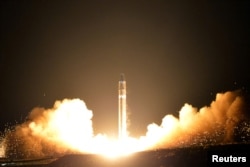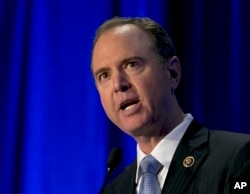U.S. President Donald Trump said Wednesday that the United States would respond to North Korea’s latest intercontinental ballistic missile test flight by slapping more sanctions on Pyongyang.
Trump mentioned new “major sanctions” in a tweet and said they would be unveiled later in the day. Administration officials declined to provide details when asked by reporters.
Later, however, a State Department spokeswoman said details on a "new level" of maritime interdiction for North Korea was being worked out.
“We want to do everything we can to put maximum pressure on North Korea,” White House press secretary Sarah Sanders said in response to a question from VOA about whether the administration thought the new sanctions would be effective. “We’re going to continue doing that in every way possible — both diplomatically, economically, and working with our partners and allies and ask them to step up and do more in this process as well.”
In a tweet Wednesday, Trump said he had spoken with Chinese President Xi Jinping about the "provocative actions" of North Korea. He again vowed that the "situation will be handled," but did not elaborate.
"President Trump underscored the determination of the United States to defend ourselves and our allies from the growing threat posed by the North Korean regime," the White House said in a statement on the call with Xi.
The readout also said Trump "emphasized the need for China to use all available levers to convince North Korea to end its provocations and return to the path of denuclearization."
Speaking to reporters on the way to Missouri on Air Force One, White House principal deputy press secretary Raj Shah declared “the North Korean threat is very grave” following Pyongyang’s claim it tested a Hwasong-15 missile "tipped with a super-large heavy warhead which is capable of striking the whole mainland of the U.S."
The missile reached an altitude of 4,500 kilometers (2,800 miles) — more than 10 times higher than orbit of the International Space Station — before splashing into Japan’s exclusive economic zone east of the Korean Peninsula, about 1,000 kilometers (620 miles) from its launch site.
The test represented a key accomplishment for Pyongyang's missile program, showing it can send rockets higher and farther than ever before, according to U.S. officials and analysts.
“It went higher, frankly, than any previous shot they have taken,” U.S. Defense Secretary Jim Mattis said Tuesday. “It's a research-and- development effort on their part to continue building ballistic missiles that can threaten everywhere in the world, basically.”
Each missile launch or atomic weapons test by Pyongyang highlights the risks of a very dangerous nuclear flashpoint, according to Robert Manning, a senior fellow on international security at the Atlantic Council, a global affairs policy research group.
“The North Korean nuclear problem is part of a larger Korea question, the last vestige of the Cold War,” said Manning. “It holds the potential to reshape geopolitics in East Asia toward either a more cooperative future or a confrontational one. The risks of nuclear war and proliferation, chaos in North Korea, and how the eventual reunification of the Korean Peninsula occurs are likely to have a transformative impact on U.S.-Chinese relations, U.S. alliances with the Republic of Korea and Japan, and the strategic equation in the region and beyond.”
The U.N. Security Council was to convene an emergency meeting later Wednesday to discuss the incident. The body has imposed repeated rounds of sanctions on the North in response to its nuclear and missile tests.
The ranking Democratic member on the House Intelligence Committee, Adam Schiff of California, noting that North Korea will soon be capable of delivering a nuclear weapon to American shores, said “it’s well past time” for the administration to use whatever diplomatic strategy it has.
“And if they do not, they need to develop one fast, as the military options are nothing short of disastrous," he said Wednesday.
That sentiment was echoed by the top Democrat on the House Foreign Affairs Committee.
“Yesterday, the bluster continued as the president uttered his third ‘red line’ to address the North Korea nuclear challenge, but so far has failed to put in place the people or strategy that could do just that,” said Representative Eliot Engel of New York.
Secretary of State Rex Tillerson, asked Wednesday how much more time he was willing to give to the pressure campaign, replied in regard to the diplomatic approach, “We keep working on it every day.”


















